Assignment on Monetary Policy and Fiscal Policy
VerifiedAdded on 2022/08/19
|9
|1396
|11
AI Summary
Contribute Materials
Your contribution can guide someone’s learning journey. Share your
documents today.
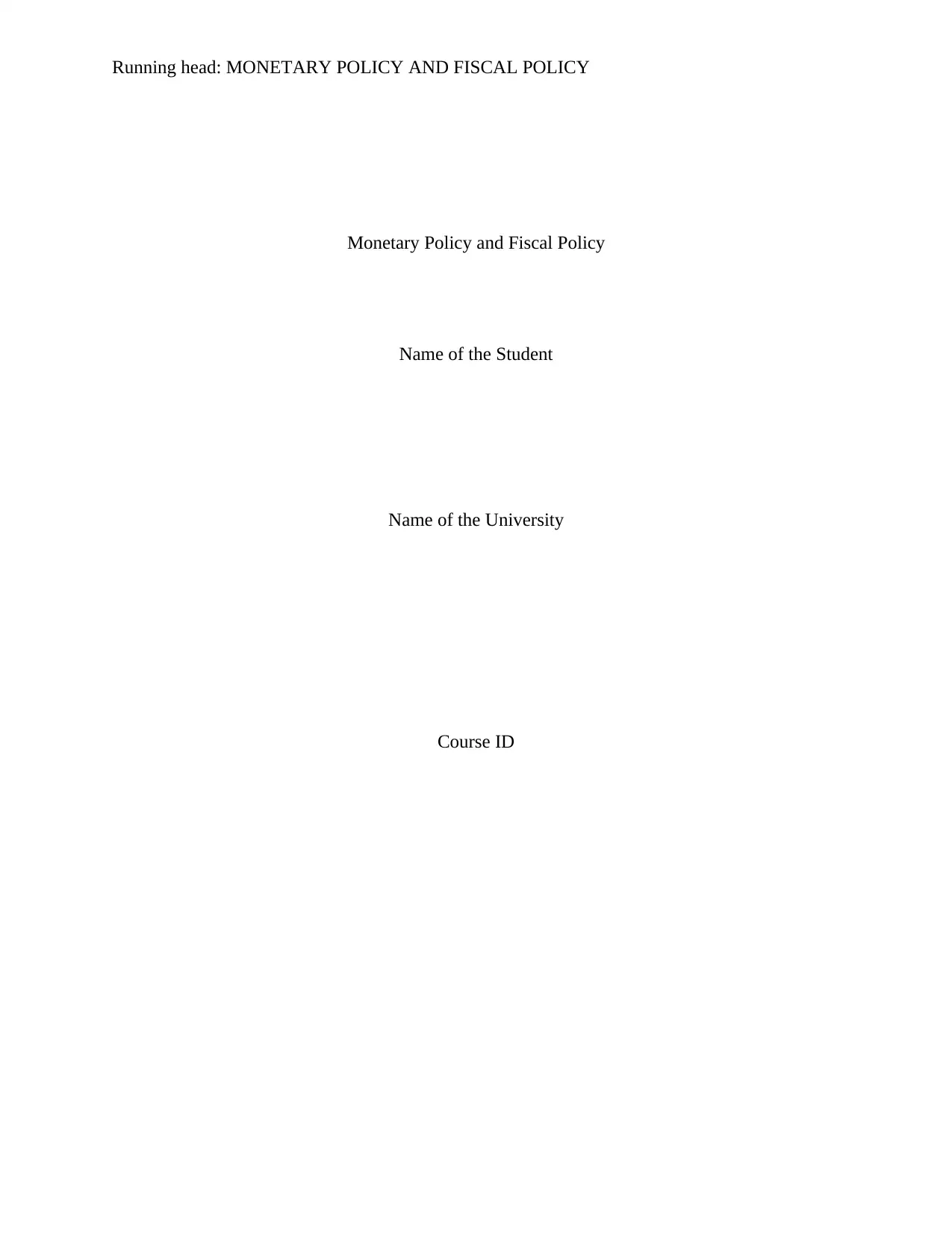
Running head: MONETARY POLICY AND FISCAL POLICY
Monetary Policy and Fiscal Policy
Name of the Student
Name of the University
Course ID
Monetary Policy and Fiscal Policy
Name of the Student
Name of the University
Course ID
Secure Best Marks with AI Grader
Need help grading? Try our AI Grader for instant feedback on your assignments.
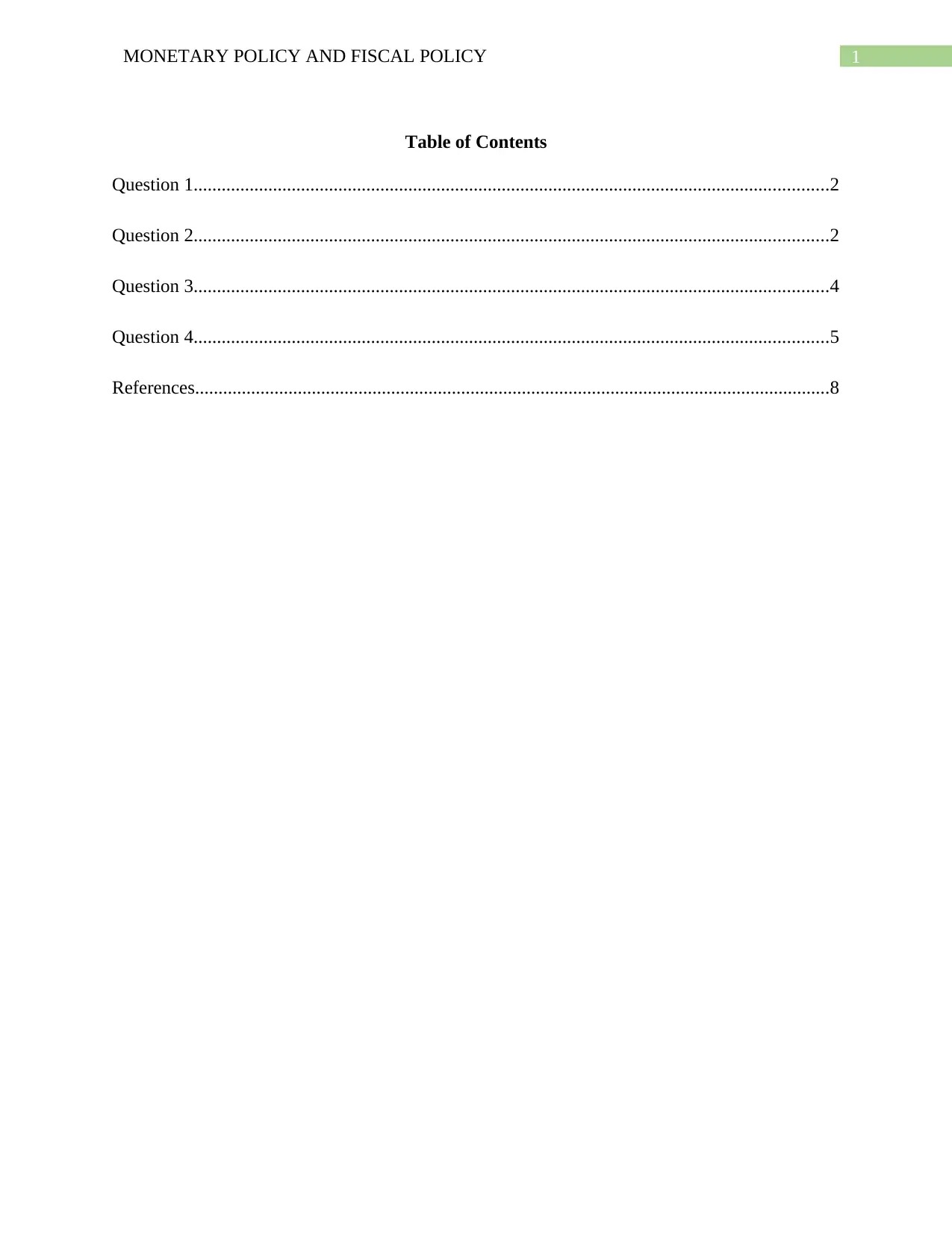
1MONETARY POLICY AND FISCAL POLICY
Table of Contents
Question 1........................................................................................................................................2
Question 2........................................................................................................................................2
Question 3........................................................................................................................................4
Question 4........................................................................................................................................5
References........................................................................................................................................8
Table of Contents
Question 1........................................................................................................................................2
Question 2........................................................................................................................................2
Question 3........................................................................................................................................4
Question 4........................................................................................................................................5
References........................................................................................................................................8
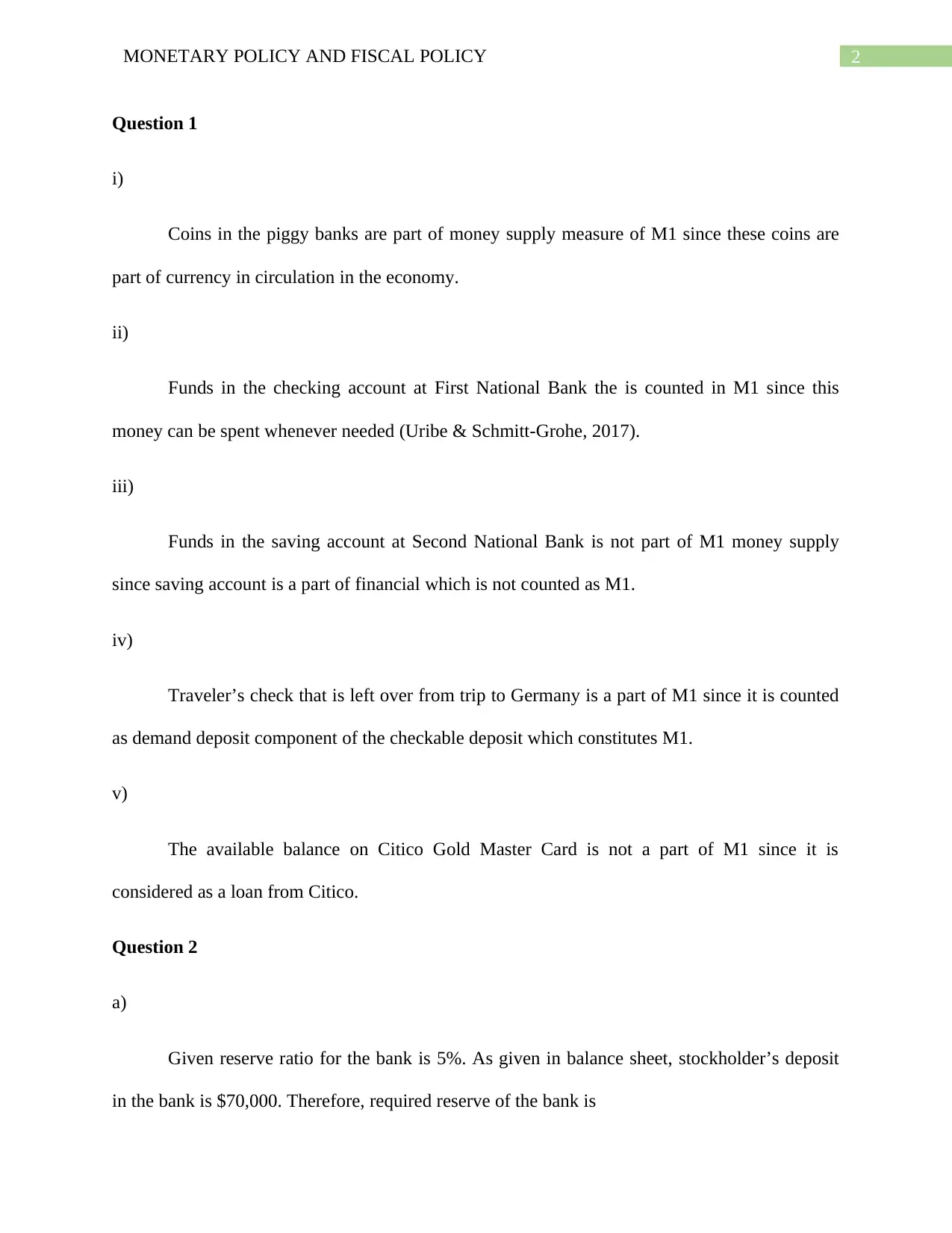
2MONETARY POLICY AND FISCAL POLICY
Question 1
i)
Coins in the piggy banks are part of money supply measure of M1 since these coins are
part of currency in circulation in the economy.
ii)
Funds in the checking account at First National Bank the is counted in M1 since this
money can be spent whenever needed (Uribe & Schmitt-Grohe, 2017).
iii)
Funds in the saving account at Second National Bank is not part of M1 money supply
since saving account is a part of financial which is not counted as M1.
iv)
Traveler’s check that is left over from trip to Germany is a part of M1 since it is counted
as demand deposit component of the checkable deposit which constitutes M1.
v)
The available balance on Citico Gold Master Card is not a part of M1 since it is
considered as a loan from Citico.
Question 2
a)
Given reserve ratio for the bank is 5%. As given in balance sheet, stockholder’s deposit
in the bank is $70,000. Therefore, required reserve of the bank is
Question 1
i)
Coins in the piggy banks are part of money supply measure of M1 since these coins are
part of currency in circulation in the economy.
ii)
Funds in the checking account at First National Bank the is counted in M1 since this
money can be spent whenever needed (Uribe & Schmitt-Grohe, 2017).
iii)
Funds in the saving account at Second National Bank is not part of M1 money supply
since saving account is a part of financial which is not counted as M1.
iv)
Traveler’s check that is left over from trip to Germany is a part of M1 since it is counted
as demand deposit component of the checkable deposit which constitutes M1.
v)
The available balance on Citico Gold Master Card is not a part of M1 since it is
considered as a loan from Citico.
Question 2
a)
Given reserve ratio for the bank is 5%. As given in balance sheet, stockholder’s deposit
in the bank is $70,000. Therefore, required reserve of the bank is
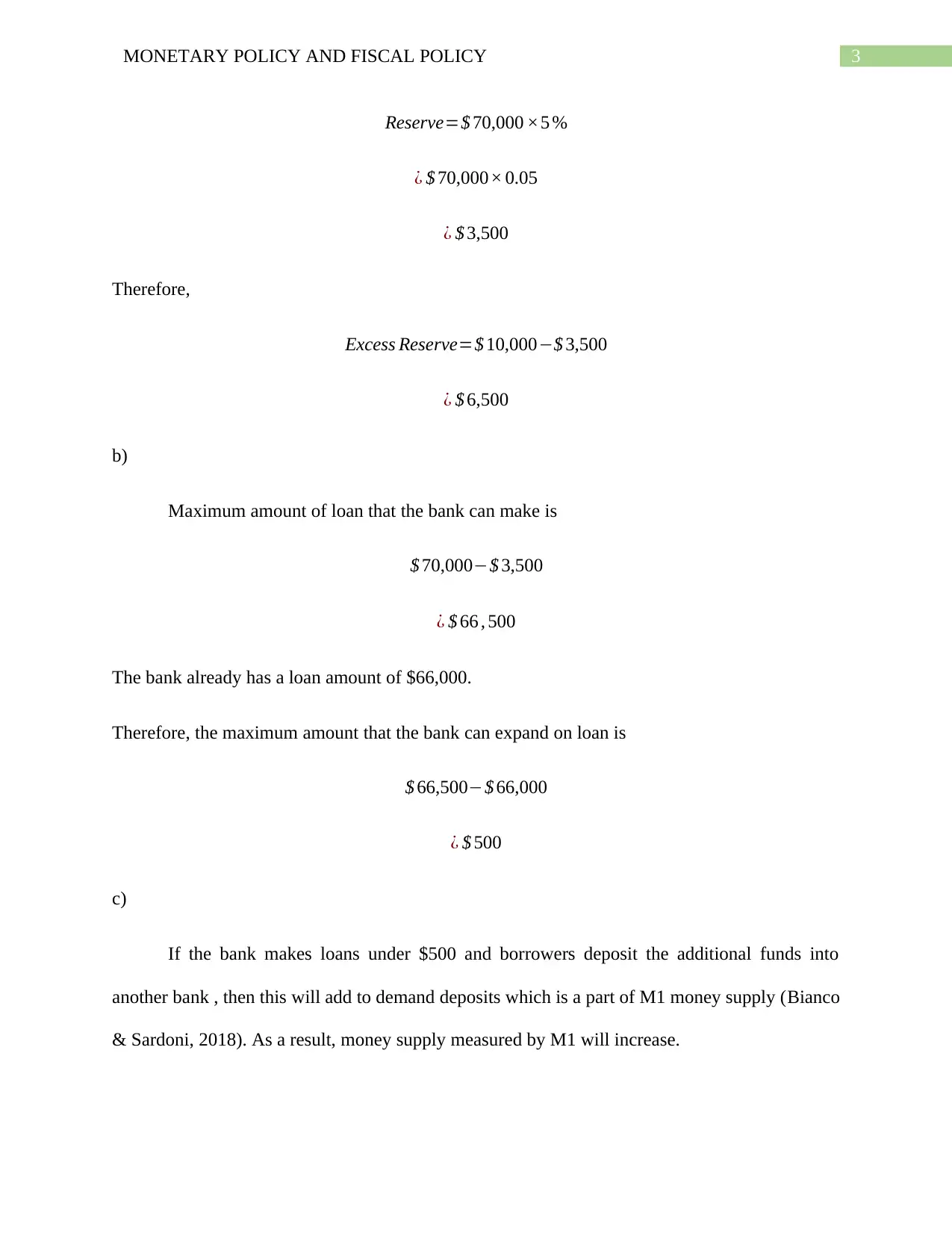
3MONETARY POLICY AND FISCAL POLICY
Reserve=$ 70,000 ×5 %
¿ $ 70,000× 0.05
¿ $ 3,500
Therefore,
Excess Reserve=$ 10,000−$ 3,500
¿ $ 6,500
b)
Maximum amount of loan that the bank can make is
$ 70,000−$ 3,500
¿ $ 66 , 500
The bank already has a loan amount of $66,000.
Therefore, the maximum amount that the bank can expand on loan is
$ 66,500−$ 66,000
¿ $ 500
c)
If the bank makes loans under $500 and borrowers deposit the additional funds into
another bank , then this will add to demand deposits which is a part of M1 money supply (Bianco
& Sardoni, 2018). As a result, money supply measured by M1 will increase.
Reserve=$ 70,000 ×5 %
¿ $ 70,000× 0.05
¿ $ 3,500
Therefore,
Excess Reserve=$ 10,000−$ 3,500
¿ $ 6,500
b)
Maximum amount of loan that the bank can make is
$ 70,000−$ 3,500
¿ $ 66 , 500
The bank already has a loan amount of $66,000.
Therefore, the maximum amount that the bank can expand on loan is
$ 66,500−$ 66,000
¿ $ 500
c)
If the bank makes loans under $500 and borrowers deposit the additional funds into
another bank , then this will add to demand deposits which is a part of M1 money supply (Bianco
& Sardoni, 2018). As a result, money supply measured by M1 will increase.
Secure Best Marks with AI Grader
Need help grading? Try our AI Grader for instant feedback on your assignments.
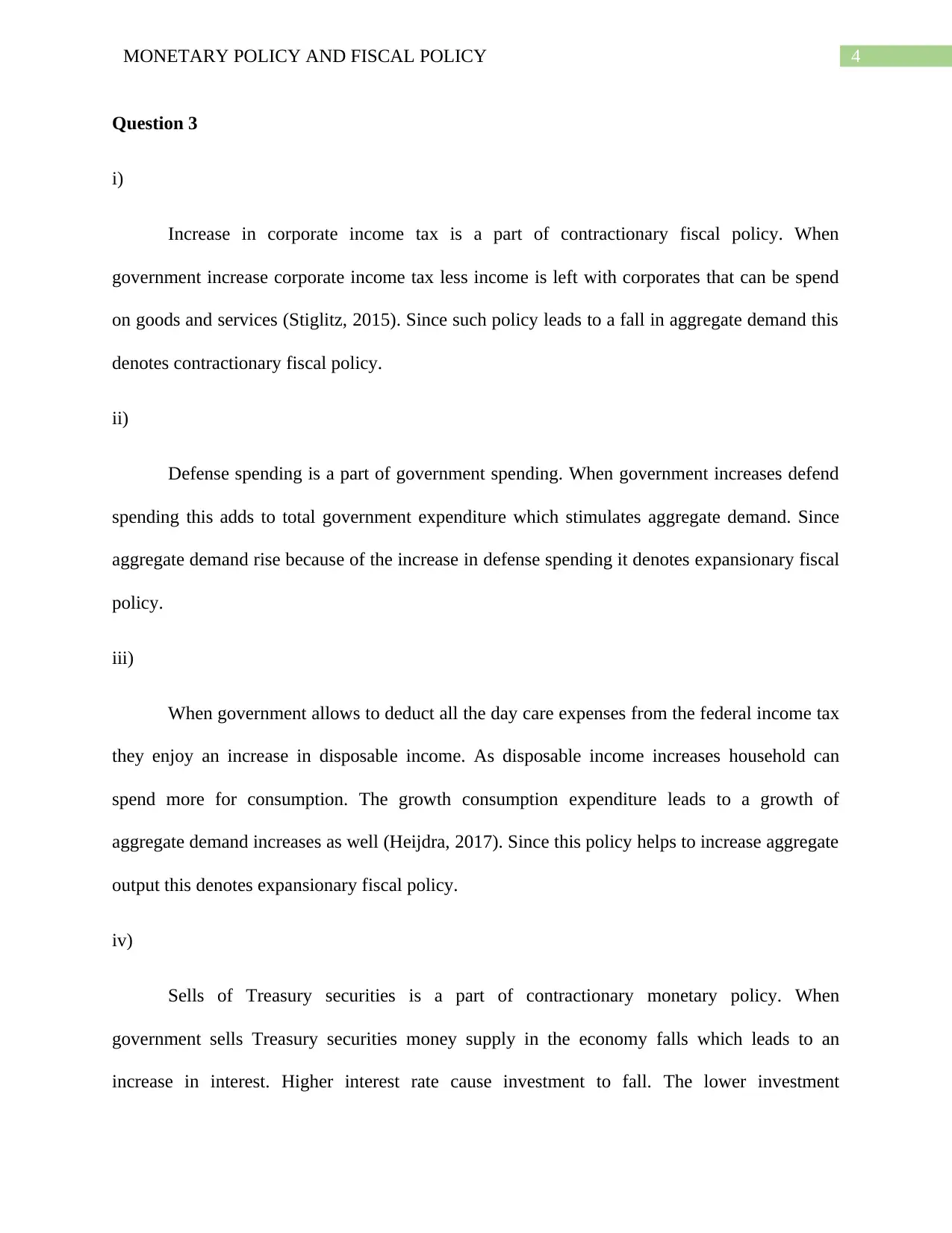
4MONETARY POLICY AND FISCAL POLICY
Question 3
i)
Increase in corporate income tax is a part of contractionary fiscal policy. When
government increase corporate income tax less income is left with corporates that can be spend
on goods and services (Stiglitz, 2015). Since such policy leads to a fall in aggregate demand this
denotes contractionary fiscal policy.
ii)
Defense spending is a part of government spending. When government increases defend
spending this adds to total government expenditure which stimulates aggregate demand. Since
aggregate demand rise because of the increase in defense spending it denotes expansionary fiscal
policy.
iii)
When government allows to deduct all the day care expenses from the federal income tax
they enjoy an increase in disposable income. As disposable income increases household can
spend more for consumption. The growth consumption expenditure leads to a growth of
aggregate demand increases as well (Heijdra, 2017). Since this policy helps to increase aggregate
output this denotes expansionary fiscal policy.
iv)
Sells of Treasury securities is a part of contractionary monetary policy. When
government sells Treasury securities money supply in the economy falls which leads to an
increase in interest. Higher interest rate cause investment to fall. The lower investment
Question 3
i)
Increase in corporate income tax is a part of contractionary fiscal policy. When
government increase corporate income tax less income is left with corporates that can be spend
on goods and services (Stiglitz, 2015). Since such policy leads to a fall in aggregate demand this
denotes contractionary fiscal policy.
ii)
Defense spending is a part of government spending. When government increases defend
spending this adds to total government expenditure which stimulates aggregate demand. Since
aggregate demand rise because of the increase in defense spending it denotes expansionary fiscal
policy.
iii)
When government allows to deduct all the day care expenses from the federal income tax
they enjoy an increase in disposable income. As disposable income increases household can
spend more for consumption. The growth consumption expenditure leads to a growth of
aggregate demand increases as well (Heijdra, 2017). Since this policy helps to increase aggregate
output this denotes expansionary fiscal policy.
iv)
Sells of Treasury securities is a part of contractionary monetary policy. When
government sells Treasury securities money supply in the economy falls which leads to an
increase in interest. Higher interest rate cause investment to fall. The lower investment
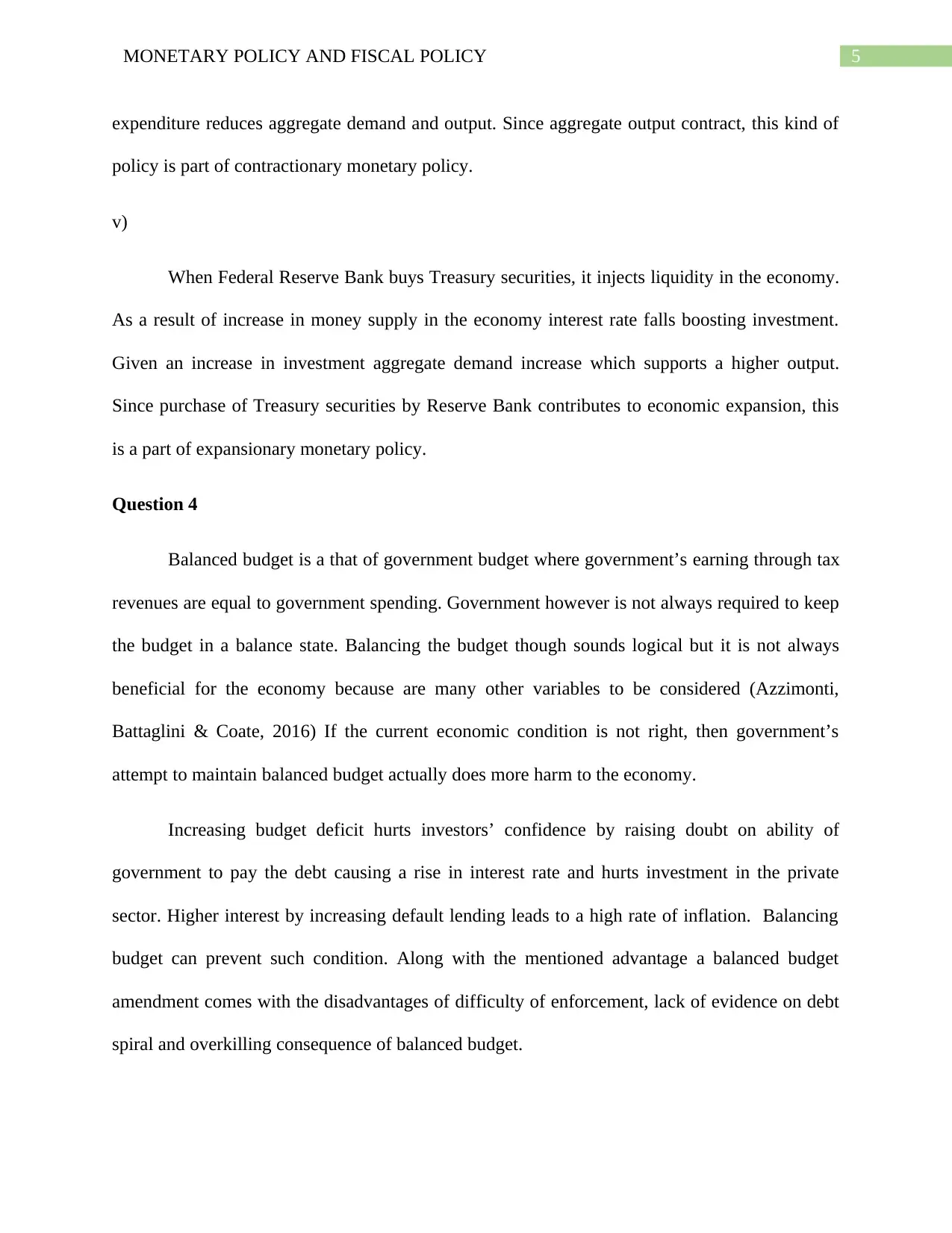
5MONETARY POLICY AND FISCAL POLICY
expenditure reduces aggregate demand and output. Since aggregate output contract, this kind of
policy is part of contractionary monetary policy.
v)
When Federal Reserve Bank buys Treasury securities, it injects liquidity in the economy.
As a result of increase in money supply in the economy interest rate falls boosting investment.
Given an increase in investment aggregate demand increase which supports a higher output.
Since purchase of Treasury securities by Reserve Bank contributes to economic expansion, this
is a part of expansionary monetary policy.
Question 4
Balanced budget is a that of government budget where government’s earning through tax
revenues are equal to government spending. Government however is not always required to keep
the budget in a balance state. Balancing the budget though sounds logical but it is not always
beneficial for the economy because are many other variables to be considered (Azzimonti,
Battaglini & Coate, 2016) If the current economic condition is not right, then government’s
attempt to maintain balanced budget actually does more harm to the economy.
Increasing budget deficit hurts investors’ confidence by raising doubt on ability of
government to pay the debt causing a rise in interest rate and hurts investment in the private
sector. Higher interest by increasing default lending leads to a high rate of inflation. Balancing
budget can prevent such condition. Along with the mentioned advantage a balanced budget
amendment comes with the disadvantages of difficulty of enforcement, lack of evidence on debt
spiral and overkilling consequence of balanced budget.
expenditure reduces aggregate demand and output. Since aggregate output contract, this kind of
policy is part of contractionary monetary policy.
v)
When Federal Reserve Bank buys Treasury securities, it injects liquidity in the economy.
As a result of increase in money supply in the economy interest rate falls boosting investment.
Given an increase in investment aggregate demand increase which supports a higher output.
Since purchase of Treasury securities by Reserve Bank contributes to economic expansion, this
is a part of expansionary monetary policy.
Question 4
Balanced budget is a that of government budget where government’s earning through tax
revenues are equal to government spending. Government however is not always required to keep
the budget in a balance state. Balancing the budget though sounds logical but it is not always
beneficial for the economy because are many other variables to be considered (Azzimonti,
Battaglini & Coate, 2016) If the current economic condition is not right, then government’s
attempt to maintain balanced budget actually does more harm to the economy.
Increasing budget deficit hurts investors’ confidence by raising doubt on ability of
government to pay the debt causing a rise in interest rate and hurts investment in the private
sector. Higher interest by increasing default lending leads to a high rate of inflation. Balancing
budget can prevent such condition. Along with the mentioned advantage a balanced budget
amendment comes with the disadvantages of difficulty of enforcement, lack of evidence on debt
spiral and overkilling consequence of balanced budget.
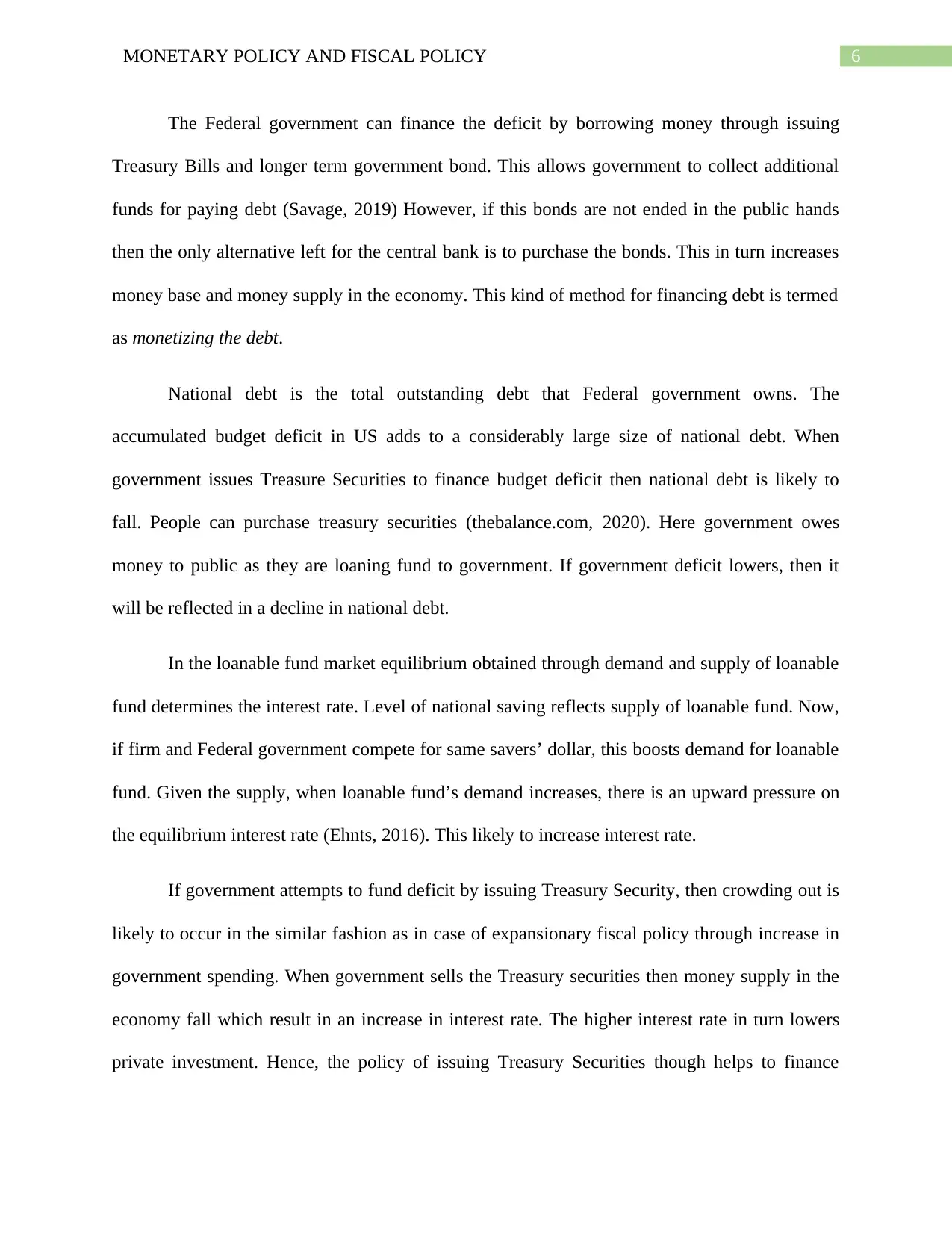
6MONETARY POLICY AND FISCAL POLICY
The Federal government can finance the deficit by borrowing money through issuing
Treasury Bills and longer term government bond. This allows government to collect additional
funds for paying debt (Savage, 2019) However, if this bonds are not ended in the public hands
then the only alternative left for the central bank is to purchase the bonds. This in turn increases
money base and money supply in the economy. This kind of method for financing debt is termed
as monetizing the debt.
National debt is the total outstanding debt that Federal government owns. The
accumulated budget deficit in US adds to a considerably large size of national debt. When
government issues Treasure Securities to finance budget deficit then national debt is likely to
fall. People can purchase treasury securities (thebalance.com, 2020). Here government owes
money to public as they are loaning fund to government. If government deficit lowers, then it
will be reflected in a decline in national debt.
In the loanable fund market equilibrium obtained through demand and supply of loanable
fund determines the interest rate. Level of national saving reflects supply of loanable fund. Now,
if firm and Federal government compete for same savers’ dollar, this boosts demand for loanable
fund. Given the supply, when loanable fund’s demand increases, there is an upward pressure on
the equilibrium interest rate (Ehnts, 2016). This likely to increase interest rate.
If government attempts to fund deficit by issuing Treasury Security, then crowding out is
likely to occur in the similar fashion as in case of expansionary fiscal policy through increase in
government spending. When government sells the Treasury securities then money supply in the
economy fall which result in an increase in interest rate. The higher interest rate in turn lowers
private investment. Hence, the policy of issuing Treasury Securities though helps to finance
The Federal government can finance the deficit by borrowing money through issuing
Treasury Bills and longer term government bond. This allows government to collect additional
funds for paying debt (Savage, 2019) However, if this bonds are not ended in the public hands
then the only alternative left for the central bank is to purchase the bonds. This in turn increases
money base and money supply in the economy. This kind of method for financing debt is termed
as monetizing the debt.
National debt is the total outstanding debt that Federal government owns. The
accumulated budget deficit in US adds to a considerably large size of national debt. When
government issues Treasure Securities to finance budget deficit then national debt is likely to
fall. People can purchase treasury securities (thebalance.com, 2020). Here government owes
money to public as they are loaning fund to government. If government deficit lowers, then it
will be reflected in a decline in national debt.
In the loanable fund market equilibrium obtained through demand and supply of loanable
fund determines the interest rate. Level of national saving reflects supply of loanable fund. Now,
if firm and Federal government compete for same savers’ dollar, this boosts demand for loanable
fund. Given the supply, when loanable fund’s demand increases, there is an upward pressure on
the equilibrium interest rate (Ehnts, 2016). This likely to increase interest rate.
If government attempts to fund deficit by issuing Treasury Security, then crowding out is
likely to occur in the similar fashion as in case of expansionary fiscal policy through increase in
government spending. When government sells the Treasury securities then money supply in the
economy fall which result in an increase in interest rate. The higher interest rate in turn lowers
private investment. Hence, the policy of issuing Treasury Securities though helps to finance
Paraphrase This Document
Need a fresh take? Get an instant paraphrase of this document with our AI Paraphraser
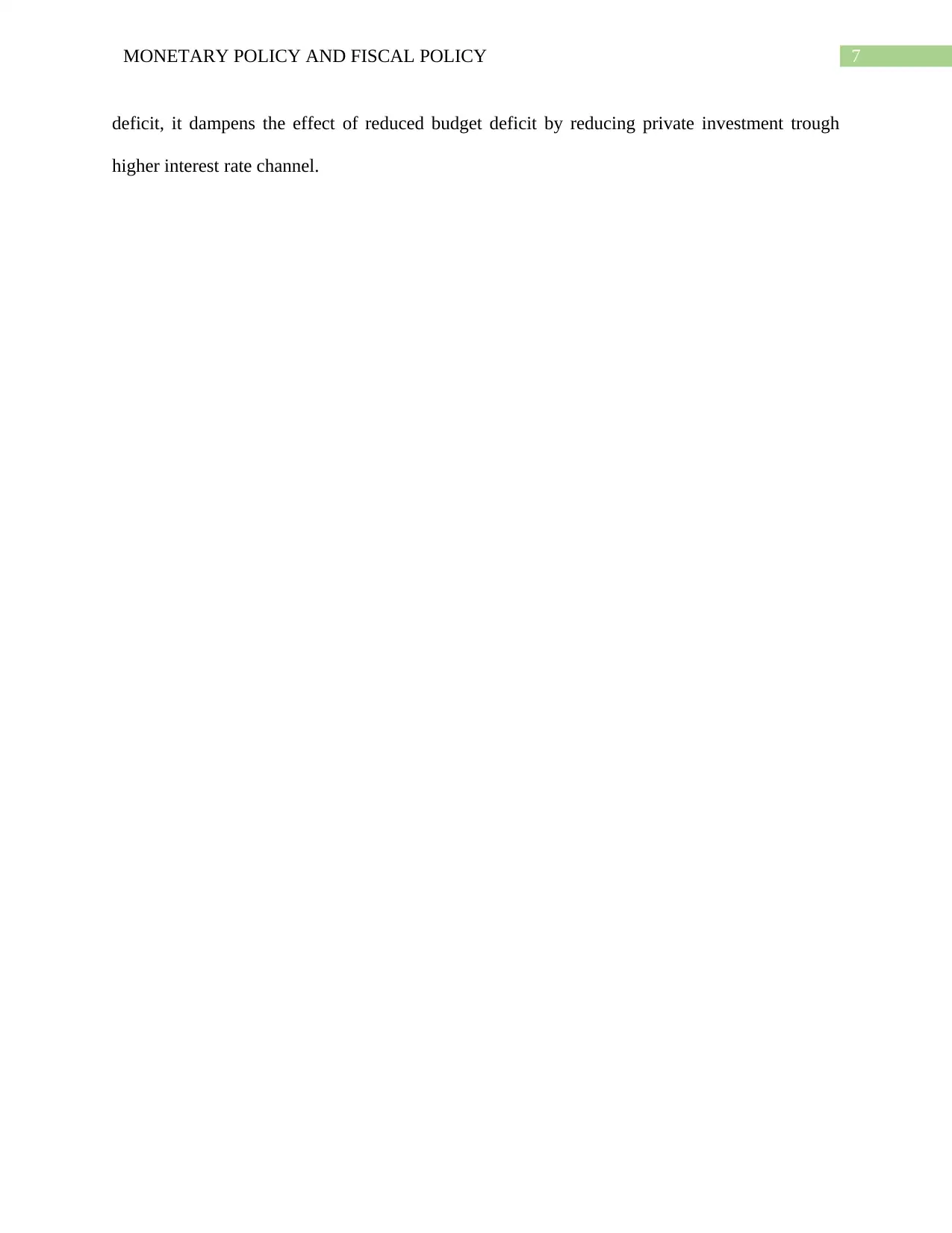
7MONETARY POLICY AND FISCAL POLICY
deficit, it dampens the effect of reduced budget deficit by reducing private investment trough
higher interest rate channel.
deficit, it dampens the effect of reduced budget deficit by reducing private investment trough
higher interest rate channel.
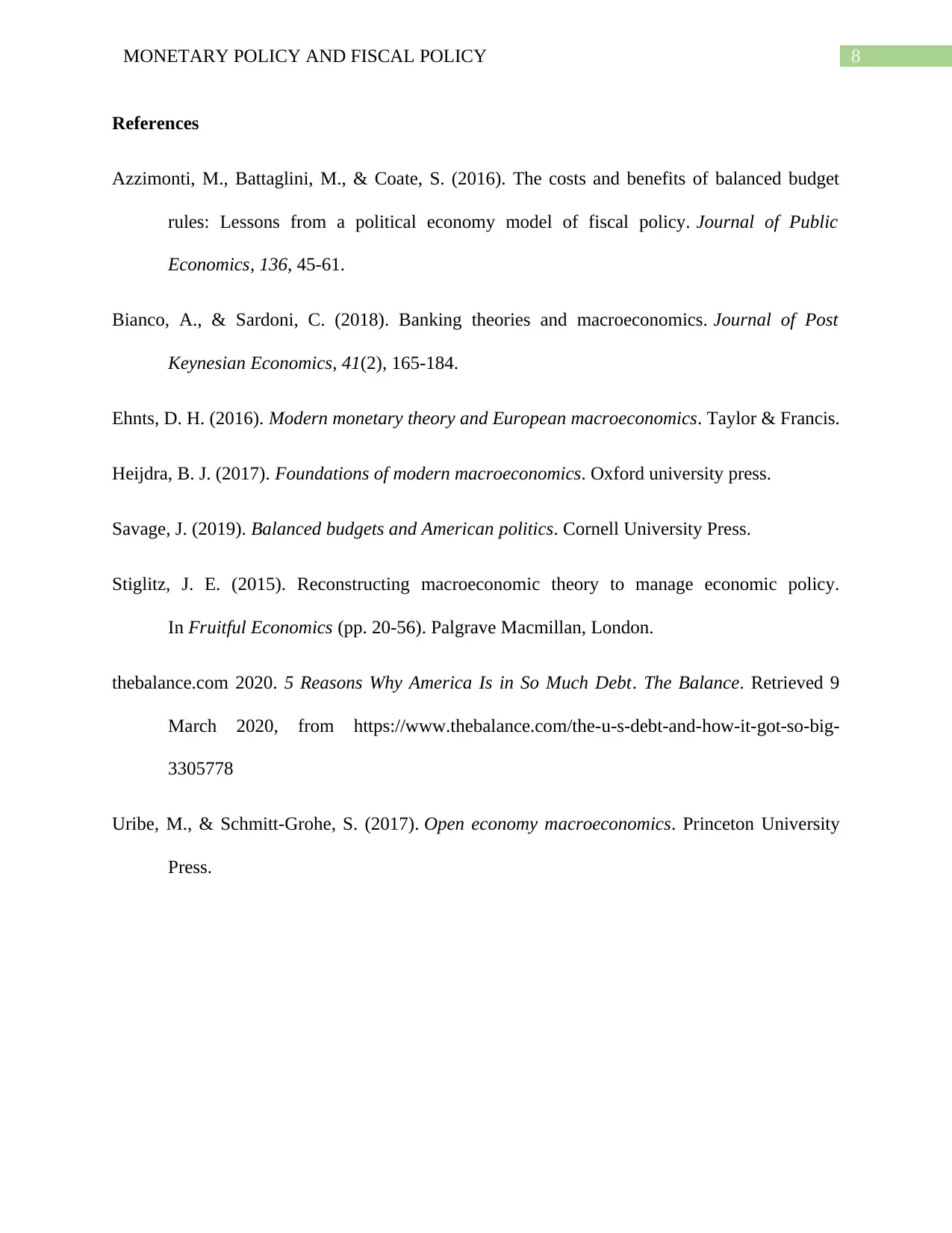
8MONETARY POLICY AND FISCAL POLICY
References
Azzimonti, M., Battaglini, M., & Coate, S. (2016). The costs and benefits of balanced budget
rules: Lessons from a political economy model of fiscal policy. Journal of Public
Economics, 136, 45-61.
Bianco, A., & Sardoni, C. (2018). Banking theories and macroeconomics. Journal of Post
Keynesian Economics, 41(2), 165-184.
Ehnts, D. H. (2016). Modern monetary theory and European macroeconomics. Taylor & Francis.
Heijdra, B. J. (2017). Foundations of modern macroeconomics. Oxford university press.
Savage, J. (2019). Balanced budgets and American politics. Cornell University Press.
Stiglitz, J. E. (2015). Reconstructing macroeconomic theory to manage economic policy.
In Fruitful Economics (pp. 20-56). Palgrave Macmillan, London.
thebalance.com 2020. 5 Reasons Why America Is in So Much Debt. The Balance. Retrieved 9
March 2020, from https://www.thebalance.com/the-u-s-debt-and-how-it-got-so-big-
3305778
Uribe, M., & Schmitt-Grohe, S. (2017). Open economy macroeconomics. Princeton University
Press.
References
Azzimonti, M., Battaglini, M., & Coate, S. (2016). The costs and benefits of balanced budget
rules: Lessons from a political economy model of fiscal policy. Journal of Public
Economics, 136, 45-61.
Bianco, A., & Sardoni, C. (2018). Banking theories and macroeconomics. Journal of Post
Keynesian Economics, 41(2), 165-184.
Ehnts, D. H. (2016). Modern monetary theory and European macroeconomics. Taylor & Francis.
Heijdra, B. J. (2017). Foundations of modern macroeconomics. Oxford university press.
Savage, J. (2019). Balanced budgets and American politics. Cornell University Press.
Stiglitz, J. E. (2015). Reconstructing macroeconomic theory to manage economic policy.
In Fruitful Economics (pp. 20-56). Palgrave Macmillan, London.
thebalance.com 2020. 5 Reasons Why America Is in So Much Debt. The Balance. Retrieved 9
March 2020, from https://www.thebalance.com/the-u-s-debt-and-how-it-got-so-big-
3305778
Uribe, M., & Schmitt-Grohe, S. (2017). Open economy macroeconomics. Princeton University
Press.
1 out of 9
Related Documents
Your All-in-One AI-Powered Toolkit for Academic Success.
+13062052269
info@desklib.com
Available 24*7 on WhatsApp / Email
![[object Object]](/_next/static/media/star-bottom.7253800d.svg)
Unlock your academic potential
© 2024 | Zucol Services PVT LTD | All rights reserved.





